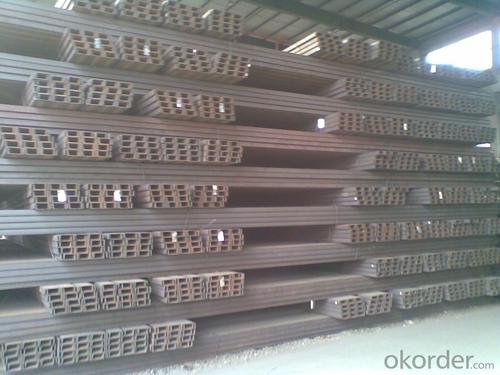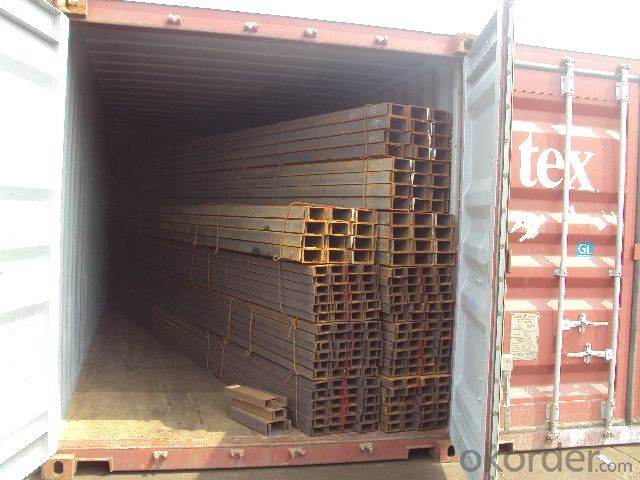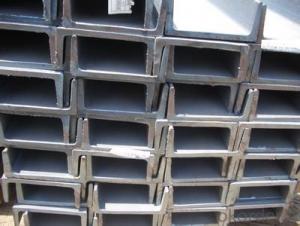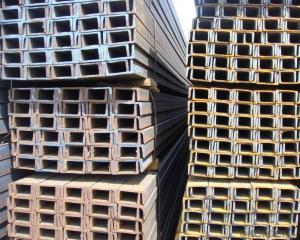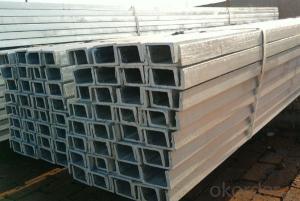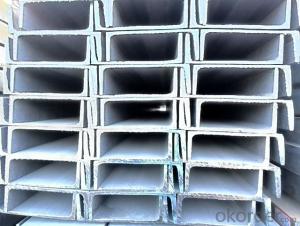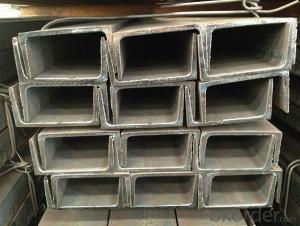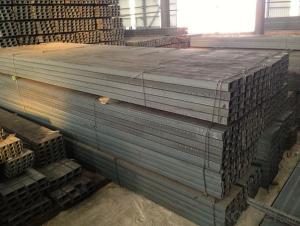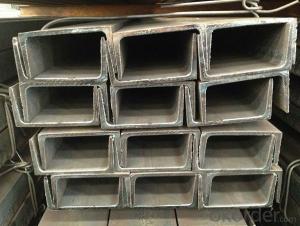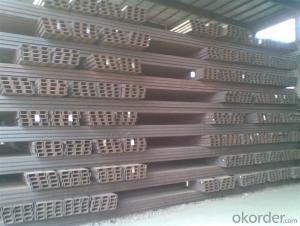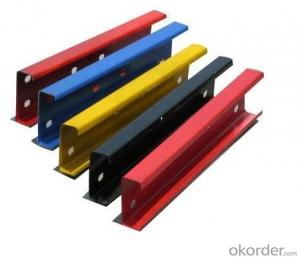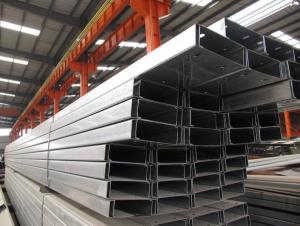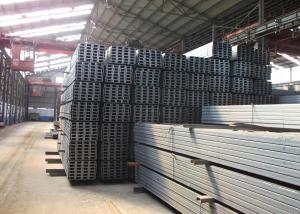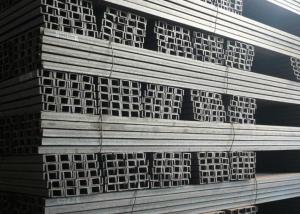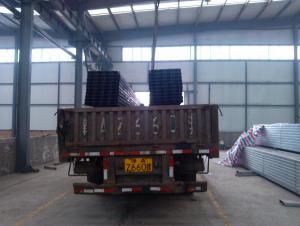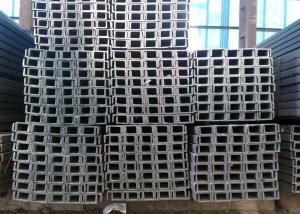Mild Steel U Channels for Structure Construction JIS,GB,UPN,UPE
- Loading Port:
- Tianjin
- Payment Terms:
- TT or LC
- Min Order Qty:
- 25 m.t.
- Supply Capability:
- 200000 m.t./month
OKorder Service Pledge
OKorder Financial Service
You Might Also Like
Product Description:
OKorder is offering Mild Steel U Channels for Structure Construction JIS,GB,UPN,UPE at great prices with worldwide shipping. Our supplier is a world-class manufacturer of steel, with our products utilized the world over. OKorder annually supplies products to European, North American and Asian markets. We provide quotations within 24 hours of receiving an inquiry and guarantee competitive prices.
Product Applications:
Mild Steel U Channels for Structure Construction JIS,GB,UPN,UPE are ideal for structural applications and are widely used in the construction of buildings and bridges, and the manufacturing, petrochemical, and transportation industries.
1. Supporting members, most commonly in the house raising industry to strengthen timber bears under houses. Transmission line towers, etc
2. Prefabricated structure
3. Medium scale bridges
4. It is widely used in various building structures and engineering structures such as roof beams, bridges, transmission towers, hoisting machinery and transport machinery, ships, industrial furnaces, reaction tower, container frame and warehouse etc.
Product Advantages:
Mild Steel U Channels for Structure Construction JIS,GB,UPN,UPE are durable, strong, and resist corrosion.
Main Product Features:
· Premium quality
· Prompt delivery & seaworthy packing (30 days after receiving deposit)
· Corrosion resistance
· Can be recycled and reused
· Mill test certification
· Professional Service
· Competitive pricing
Specifications of Mild Steel U Channels for Structure Construction JIS,GB,UPN,UPE:
| Original Place | Tangshan, China | Brand Name | Bridge |
| Standard | GB707-88, EN100025, JIS G3192, DIN 1026 | ||
| Sizes | 50mm to 300mm | ||
| Sales Volume/Year | 3000MT | ||
| Main Market | Middle East, Africa, Southeast As | ||
1.We are able to provide channel steel of top quality at attractive price.
2.Our products of channel steel have passed ISO9001:2008 Quality Management System Certification.
3. The section of Mild Steel U Channels for Structure Construction JIS,GB,UPN,UPE are as followings in the table.
| JIS U CHANNEL | Standard h | Sectional b | Dimension s | t | Mass: Kg/m |
| (mm) | (mm) | (mm) | (mm) | ||
| 50x25 | 50 | 25 | 3.0 | 6.00 | 2.37 |
| 75X40 | 75 | 40 | 3.8 | 7.00 | 5.30 |
| 75X40 | 75 | 40 | 4.0 | 7.00 | 5.60 |
| 75X40 | 75 | 40 | 4.5 | 7.00 | 5.85 |
| 75X40 | 75 | 40 | 5.0 | 7.00 | 6.92 |
| 100X50 | 100 | 50 | 3.8 | 6.00 | 7.30 |
| 100X50 | 100 | 50 | 4.2 | 6.00 | 8.03 |
| 100X50 | 100 | 50 | 4.5 | 7.50 | 8.97 |
| 100X50 | 100 | 50 | 5.0 | 7.50 | 9.36 |
| 125X65 | 125 | 65 | 5.2 | 6.80 | 11.66 |
| 125X65 | 125 | 65 | 5.3 | 6.80 | 12.17 |
| 125X65 | 125 | 65 | 5.5 | 8.00 | 12.91 |
| 125X65 | 125 | 65 | 6.0 | 8.00 | 13.40 |
| 150x75 | 150 | 75 | 5.5 | 7.30 | 14.66 |
| 150x75 | 150 | 75 | 5.7 | 10.00 | 16.71 |
| 150x75 | 150 | 75 | 6.0 | 10.00 | 17.90 |
| 150x75 | 150 | 75 | 6.5 | 10.00 | 18.60 |
4. Chemical Compostion of Mild Steel U Channels for Structure Construction JIS,GB,UPN,UPE
| Grade | Element(%) | |||
| C | Mn | P | S | |
| SS330 | -- | -- | ≦0.050 | ≦0.050 |
| SS400 | ||||
| SS490 | ||||
| SS540 | ≦0.30 | ≦1.60 | ≦0.040 | ≦0.040 |
Usage/Applications of Mild Steel U Channels for Structure Construction JIS,GB,UPN,UPE:
Mild Steel U Channels for Structure Construction JIS,GB,UPN,UPE is usually used for building structure, vehicle manufacturing and other industrial structure and often used with i beam.
In details, the channel steel belongs to carbon structural steel which is applied to in the field of construction and machinery. The channel steel is usually used for arch-itechtural structure, and they could be welded in order to support or hang a vari-ety of facilities. They are also usually used in combination with I beam. Generally,the channel steel must possess perfect welding property, riveting property and mechanical property and so on.
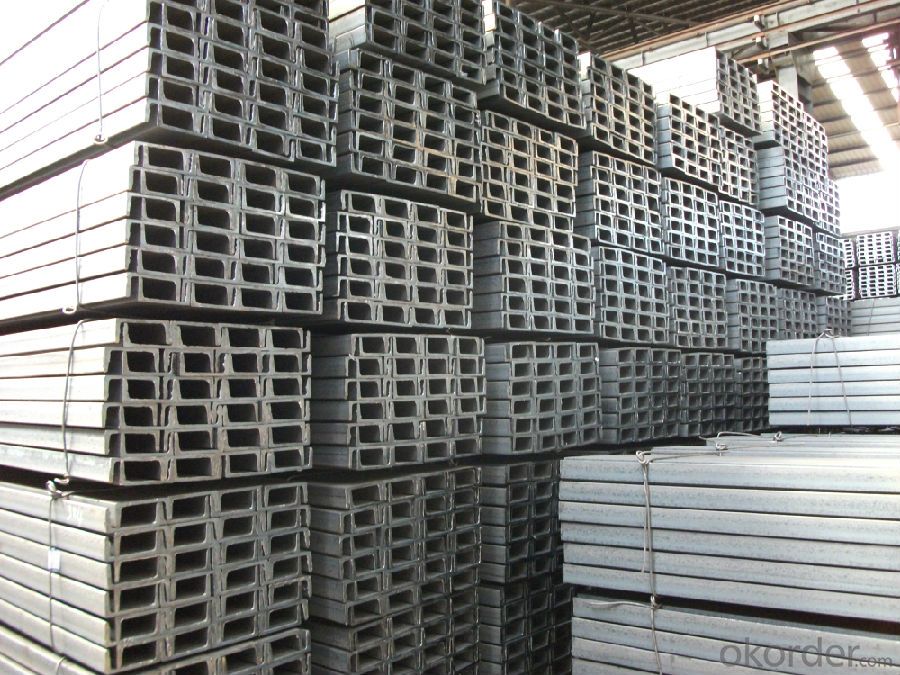
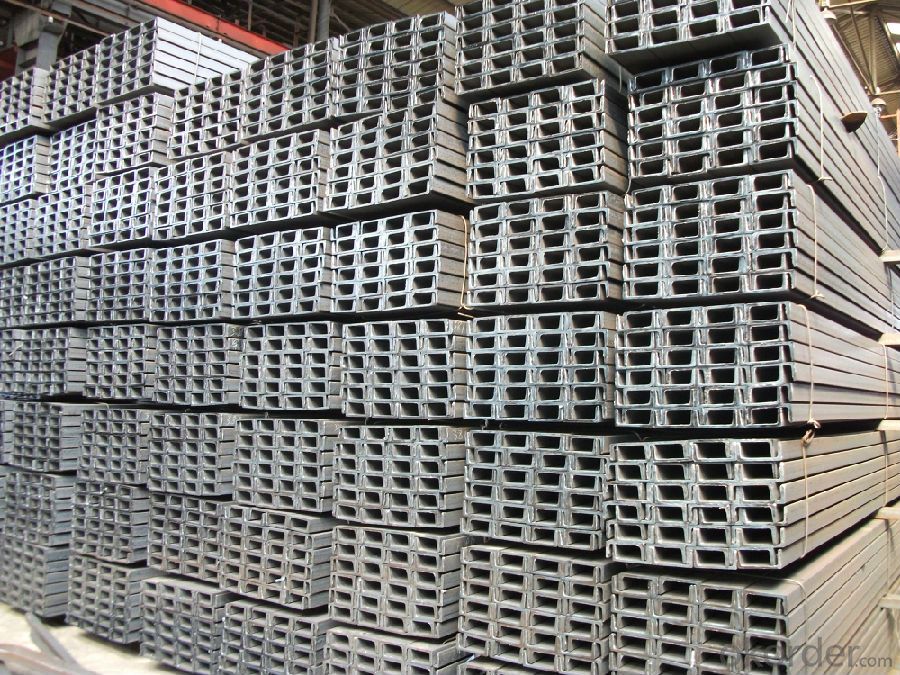
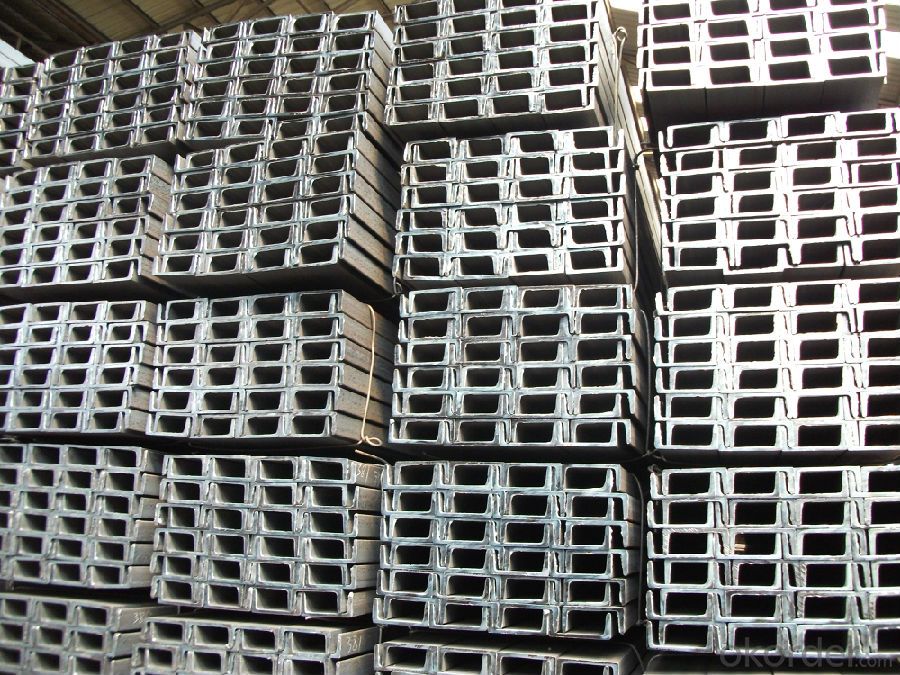
Package & Delivery of Mild Steel U Channels for Structure Construction JIS,GB,UPN,UPE:
The steel u channel will be packed in bundle with steel wire at each end of every bundle and color marking in order to help the customer to recognize his goods more easily at sight.
And steel u channel could be loaded into 20ft or 40ft container, or by bulk cargo. If the weight of each bundle reaches less than 3.5 mt, the loading by break bulk cargo should be choosed. When the weight of each bundle reaches less than 3mt, the loading by container should be choosed.
As for the transportaion from mill to loading port, the truck will be usually used. And the maximum quantity for each truck is 40mt.
All in all, we could do in accordance with customer's request.
Production Flow of Mild Steel U Channels for Structure Construction JIS,GB,UPN,UPE:
1.The steel billet shall be heated in the high temperature furnace.
2. The heated steel billet shall be rolled five to nine times with the aim of shaping the general figure of steel u channel.
3. The rolled steel u channel should be put onto the cooling bed to make the temperature low.
4. The steel u channel should be straighted on the straightener.
5. The straighted steel u channel will be cut into meters by saw, as per customer's requirements.
Outdoor leisure chair is living in a very common chairs, we when not to use the can to its folding and unfolding.
Outdoor leisure chair is designed according to human engineering, not only in the folding retractable is very convenient and dual-purpose chair bed. Tube is to use it as a chair or as a bed to use, you can sleep on it. Is the home travel, outdoor leisure necessary products.
Outdoor leisure chairs can be generally classified into three broad categories: steel pipe phosphide folding chair, Oxford cloth folding chair and carbonized bamboo chair folding chair generally use seamless steel tube as raw material, and then some anti oxidation treatment, the dust on the both ends of the steel tube mounted on the plug. The antiseptic effect of oxidation treatment is stronger than. Especially for the sun and beach chairs, it is even more important. Oxford cloth chair has the advantages of easy cleaning, feel good, the advantages of strong moisture absorption ability etc..
Outdoor leisure chair structure as is human body joints in general, every part of it is moving, is generally consists of a cushion, a chair back and leg and several major components, between all parts again by the screw connection. Such a design, not only can play the role of folding, but also allows users to adjust to the appropriate height according to their needs. Many people used in outdoor leisure chairs, do not want to use other chairs.
Steel Channel is a groove-shaped cross-section of the steel strip. Channel mainly used for building structure, curtain wall engineering, machinery manufacturing and other equipment and vehicles. In use required to have good welding, riveting performance and mechanical properties.
Steel Channel refers to a channel hot-rolled, hot-rolled steel sheet production process and, as the ingots are heated to a certain temperature, the basic steel into the thermoplastic state, then formed by rolling mill. Cold-rolled and cold-formed channel steel production process is basically the same, refers to the steel at room temperature through external action, will be made of steel rolled or curved shape needed. Due to the large difference between the two production processes, therefore, the two are very different performance, hot-rolled steel sheet or hot-rolled steel cold-rolled low intensity ratio, but the plastic deformation ability.
The specifications to waist high (h) * leg width (b) * waist thick (d) the number of millimeters expressed as 120 * 53 * 5, showing the high waist of 120 mm, leg width of 53 mm channel, thick waist 5 mm channel, or 12 # channel. Waist high the same channel, if several different legs wide and thick waist also need to model the right plus a b c be distinguished, such as 25a # 25b # 25c # and so on. Under normal circumstances, the same model (the same value) channel, b-type legs wide and thick waist is greater than a number, so the value per unit length of the same channel type, b-type than a heavy type.
- Q: The pressure is: 50TLength: 1 meters or soMaterial: steel or steelSpecifications: please tell me how much you can use!Prawns help you ah! Urgent! Online, etc.!
- 50t concentrated force in the middle of the words.500KN x 0.25m=125KNmWx>=125000000/215=581395.3mm3More than [36a or more than 36a components are recommended.
- Q: Channel 12, span 5 meters, how much weight can be carried?
- Some of the basic parameters of the 20b channel check (per unit length, weight g, section modulus W), check the "mechanical design manual" g=25.77kg/m=0.2577kg/cm W=191.4cm fand.
- Q: Can steel channels be used for elevator shafts?
- Yes, steel channels can be used for elevator shafts. Steel channels, which are structural components made of steel in a "C" shape, are commonly used in construction for various purposes, including elevator shafts. Steel channels provide strength, stability, and support to the elevator shaft structure, ensuring its ability to withstand the weight and load of the elevator car, as well as any additional loads such as people or heavy equipment. Additionally, steel channels can be easily fabricated and customized to fit the specific requirements of the elevator shaft, making them a suitable choice for this application.
- Q: What is the cost of steel channels compared to other materials?
- The cost of steel channels compared to other materials can vary depending on various factors such as the type and grade of steel, market demand, and location. Generally, steel channels tend to be more expensive than certain materials like wood or aluminum, but they can be more cost-effective compared to others like stainless steel or titanium. Steel channels offer several advantages that justify their higher cost. They are known for their strength, durability, and resistance to corrosion, making them suitable for various applications in construction, manufacturing, and infrastructure projects. Steel channels also have excellent load-bearing capabilities, allowing them to support heavy loads and withstand extreme conditions. Additionally, steel channels are readily available in standard sizes and can be easily sourced from local suppliers or manufacturers. This availability and accessibility contribute to lower transportation costs compared to materials that may need to be imported. It's worth noting that the cost of steel channels can also be influenced by market fluctuations, such as changes in raw material prices or tariffs. Therefore, it is important to conduct thorough research and obtain quotes from different suppliers to get an accurate understanding of the current cost of steel channels in relation to other materials.
- Q: What are the different types of support methods for steel channels?
- There are several different types of support methods for steel channels, depending on the specific application and structural requirements. Some common support methods include: 1. Beam and column supports: Steel channels can be supported by beams and columns, which provide vertical support and distribute the weight of the channel. This is a common method used in building construction, where steel channels are often used as structural members. 2. Hanging supports: Steel channels can be suspended from above using hanging supports such as rods, cables, or chains. This method is often used in applications where the channel needs to be elevated or hung from a ceiling or overhead structure. 3. Bracket supports: Steel channels can be supported by brackets, which are fixed to a wall or other surface. Brackets provide lateral support and stability to the channel, preventing it from bending or twisting under load. This method is commonly used in shelving systems or wall-mounted installations. 4. Channel supports: Steel channels can also be supported by other channels, creating a system of interconnected support. This method is often used in applications where multiple channels need to be joined together to form a larger structure or framework. 5. Channel cleats: Steel channels can be supported using channel cleats, which are metal brackets that are bolted or welded to the channel and then fixed to a supporting structure. This method provides a secure and rigid connection between the channel and the support. 6. Channel frames: Steel channels can be supported by framing systems, where multiple channels are connected together to form a frame or structure. This method is commonly used in applications such as conveyor systems or equipment supports. Overall, the choice of support method for steel channels depends on factors such as the specific application, load requirements, and desired level of stability and rigidity. Professional engineers and designers should carefully consider these factors to select the most appropriate support method for their specific project.
- Q: How do steel channels contribute to sustainable design in buildings?
- Steel channels contribute to sustainable design in buildings in several ways. Firstly, steel is a highly durable and long-lasting material, which means that buildings constructed with steel channels have a longer lifespan, reducing the need for frequent renovations or replacements. This results in less waste generation and a lower environmental impact. Secondly, steel is a recyclable material, which means that steel channels can be recycled and reused after the end of their life cycle. This helps to reduce the demand for new steel production and the associated energy consumption and greenhouse gas emissions. Additionally, steel channels allow for efficient and flexible design options, enabling the construction of lighter and more efficient structures. This leads to reduced material consumption, improved energy efficiency, and lower carbon footprint during the construction and operation phases of the building. Furthermore, steel channels are often used in prefabricated construction methods, which can significantly reduce construction waste, minimize on-site disruption, and improve overall construction efficiency. Overall, the use of steel channels in building design contributes to sustainability by promoting durability, recyclability, energy efficiency, and reduced waste generation, making it a preferred choice for sustainable building practices.
- Q: 14# dimension of channel steel and weight per metre?
- Specification for dimensions and weight of hot rolled ordinary channel steel14#a height (H) 140, leg width (b) 58, waist thickness (d) 6, theoretical weight 14.535 kg14#b height (H) 140, leg width (b) 60, waist thickness (d) 8, theoretical weight 16.733 kg
- Q: Are steel channels suitable for use in broadcasting towers?
- Yes, steel channels are suitable for use in broadcasting towers. They provide structural stability, support heavy equipment, and withstand environmental conditions, making them an ideal choice for constructing durable and reliable broadcasting towers.
- Q: What is the difference between steel tubes such as channel steel and square tube?
- The channel for supporting, steel used for machining shaft and pin and the like, used to make steel keel frame and embedded parts in civil engineering, steel used for heavy support for small angle support or molding square tube used for various doors and windows, modification.
- Q: What are the different types of connections used with steel channels?
- There are several types of connections used with steel channels, including welding, bolting, and using steel channel connectors.
Send your message to us
Mild Steel U Channels for Structure Construction JIS,GB,UPN,UPE
- Loading Port:
- Tianjin
- Payment Terms:
- TT or LC
- Min Order Qty:
- 25 m.t.
- Supply Capability:
- 200000 m.t./month
OKorder Service Pledge
OKorder Financial Service
Similar products
Hot products
Hot Searches
Related keywords



